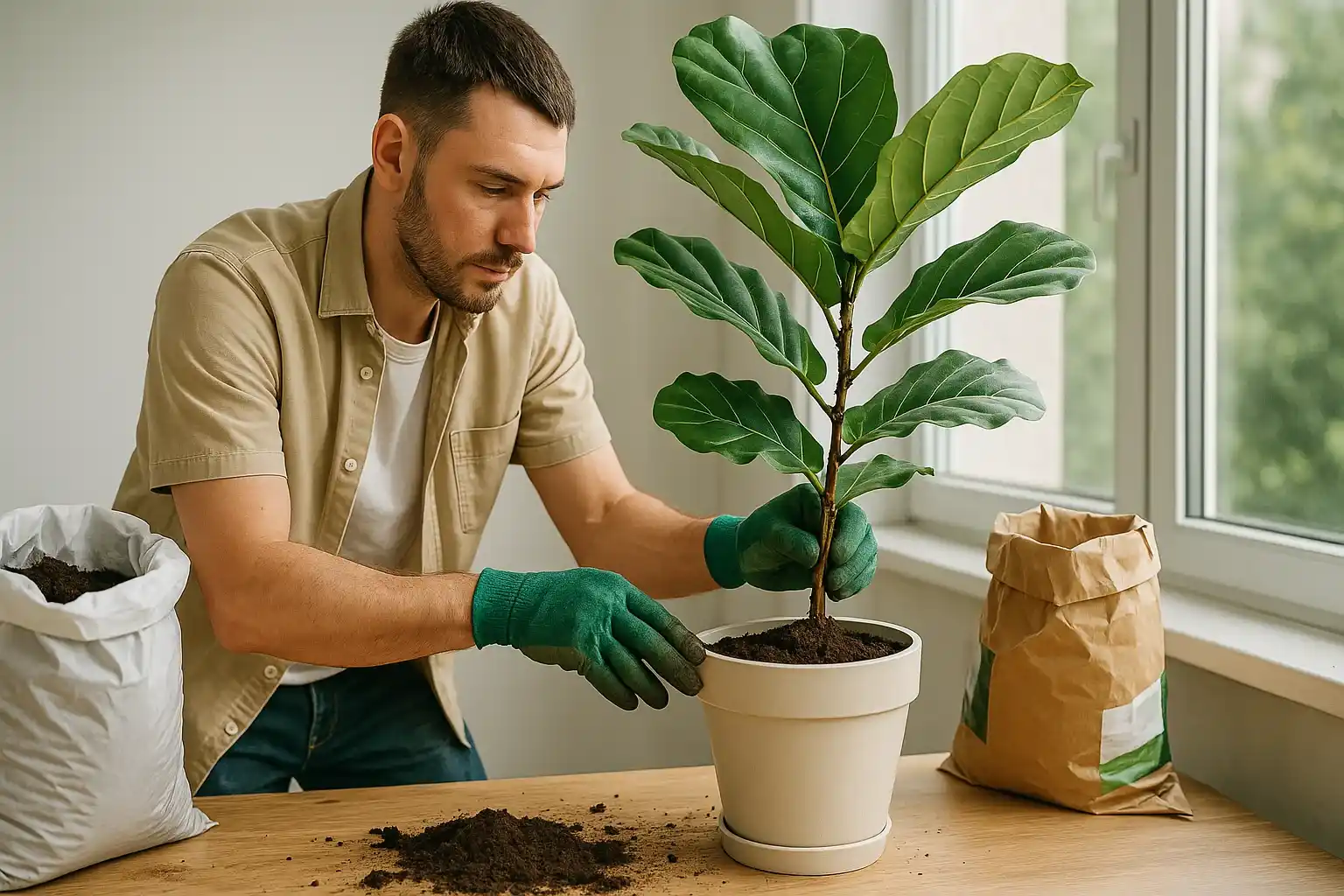Few indoor plants have captured the spotlight quite like the fiddle leaf fig, or Ficus lyrata. And it became an interior design symbol, appearing in stylish homes, cafés, and even offices around the world. It’s bold, it’s beautiful — but it’s not always easy.
Ficus lyrata care demands attention, but the payoff is worth it. If you treat it right, this plant rewards you with lush green foliage that brings any space to life. So, today we are talking about its care basics and how to fight diseases and pests quickly to help plants thrive for many years.
Well, first things first and before we go to the “how-to,” let’s talk about the plant itself. Ficus lyrata, better known as the fiddle leaf fig, is one of houseplants that immediately grabs attention. Its giant, violin-shaped leaves are bold, shiny, and almost too perfect to be real.
In the wild, this plant can grow into a full-sized tree, reaching impressive heights in the rainforests of West Africa. Indoors, of course, it stays much smaller, but even a potted fiddle leaf fig can easily tower over your sofa if it’s happy.
Still, with all that beauty comes a bit of attitude. Fiddle leaf figs are known for being picky about their environment. Too little light, too much water, or a sudden draft, and they’ll let you know right away by dropping leaves or looking sulky. But here’s the good news: once you figure out their preferences, they’re not nearly as scary as their reputation suggests. Think of it this way — ficus lyrata care isn’t about perfection, it’s about paying attention. Give it consistency, and it will reward you with those gorgeous, glossy leaves for years.

A healthy fiddle leaf fig starts with the basics. Think of these as the golden rules for keeping your plant happy:
Light: Loves bright, indirect light. Direct sun can scorch the leaves, leaving brown, crispy spots. So, remember to rotate your pot every couple of weeks so it grows evenly.
Soil: Use a loose, well-draining mix. Adding perlite or bark chips makes it airy — just like the soil it would find in the wild.
Watering: Forget strict schedules. Use the “finger test” — stick your finger an inch into the soil. If it feels dry, water. If not, wait. It’s safer underwater than overwater.
Humidity: Prefers 50–65%. You can boost it with a humidifier or by placing the pot on a pebble tray with water.
Temperature: Keep it steady. Avoid drafty spots, air conditioners, or heaters that can stress the plant.
Get these basics right, and you’ve already solved half the battle. Most diseases and pests strike when the plant is weak — so prevention really does start here.
Your fiddle leaf fig may look tough with its big glossy leaves, but it actually has a sensitive side. If something’s off, it won’t stay silent for long — it will start sending you little warning signals. The key is to notice them early before they turn into a bigger problem.
Here are the most common red flags to watch out for:
Dropping lower leaves – Totally normal as your plant grows taller. Think of it as your fig “shedding old clothes”. No need to panic if it’s just the bottom leaves.
Yellow or brown spots – This usually means you’ve overwatered, underwatered, or the plant got scorched by too much direct sunlight.
Curling leaves – A classic SOS for more humidity. Your fiddle leaf loves a little tropical mist now and then.
But don’t just stop at spotting problems. Pay attention to the context. For example, if you notice yellow spots right after you move the plant closer to the window, the culprit might be sunburn rather than watering. Or if curling leaves happen in winter, your heating system could be drying out the air.
Pro tip: Start a simple “care diary”. Note when you water, fertilize, clean leaves, or prune. It doesn’t have to be fancy — even jotting things down in your phone works. Over time, you’ll spot patterns that explain why certain issues pop up.
And here’s a modern hack: use an app like AI Plant Finder. Snap a quick photo if your fig looks unhappy, and the app can help identify whether it’s a watering mistake, pest issue, or lighting problem. Pairing your own observations with smart tools makes plant care much less stressful.
The main takeaway? Don’t ignore small changes. Your fiddle leaf fig is basically a drama queen — it tells you right away when it’s upset. Catch the signals early, and you’ll keep your plant thriving instead of just surviving.
Even the most glamorous houseplants sometimes run into trouble, and Ficus lyrata is no exception. The good news is that with a bit of observation and quick action, you can catch most issues before they turn serious. Let’s take a look at the most common diseases and pests your fiddle leaf fig might face — and how to fight back.
Your plant’s big glossy leaves may look invincible, but they can be surprisingly sensitive. Here are the usual suspects when health problems show up:
Disease | How to Recognize It | What to Do |
Root rot | Yellowing leaves, mushy roots, bad smell | Repot into fresh, dry soil; trim rotten roots |
Fungal spots | Dark, irregular dots on leaves | Apply a fungicide, cut off heavily damaged leaves |
Powdery mildew | White, dusty coating on leaves | Increase air circulation, treat with fungicide spray |
Pro tip: Prevention is your best friend. Wipe the leaves gently with a soft, damp cloth once a week, and don’t forget to peek under the leaves — this is often where trouble begins.
Unfortunately, your fiddle leaf fig is a magnet for tiny freeloaders. Most of them are easy to spot once you know what to look for:
Pest | Signs to Watch For | Quick Fix |
Spider mites | Fine webbing, speckled leaves | Wipe with soapy water, increase humidity |
Mealybugs | White cottony clumps in leaf joints | Dab with alcohol-soaked cotton swab |
Scale insects | Sticky residue, shiny patches | Gently scrape off, use insecticidal soap |
Aphids | Clusters on young shoots and leaves | Wash off with water or spray mild insecticide |
Practical advice: Always isolate new plants for at least two weeks before placing them next to your fiddle leaf fig. A little quarantine can save you from a big infestation.
Sometimes, despite your best efforts, you’ll notice your plant struggling. So, here is a simple step-by-step action plan to rescue it:
Inspect and isolate. Move the plant away from others to stop the spread.
Identify the problem. Is it a pest or a disease? Look at roots, leaves, and stems carefully.
Choose the right treatment. Start small with gentle methods (soapy water, neem oil, or a soft cloth).
Escalate if needed. If the issue persists, bring in the “big guns” like fungicides or insecticides.
Lifehack: Always begin with natural or mild remedies. Chemicals should be your last resort, not your first step.

When it comes to Ficus lyrata, you should know that prevention is your best friend. Most problems start small — too much water here, a dusty leaf there — and then spiral if ignored. A little routine care keeps your plant thriving for years.
Don’t forget the leaves. Wiping them with a damp cloth not only keeps them glossy but also clears dust so the plant can “breathe.” It’s like a mini spa day for your ficus.
Watering and light come next. Balance is key: not too soggy, not bone-dry. Test the soil with your finger — if the top inch feels dry, it’s time to water. Place your plant in a bright room, but keep it out of the harsh midday sun.
Your ficus is also a bit hungry. In spring and summer, feed it every 4–6 weeks with a balanced houseplant fertilizer. In cooler months, let it rest.
Repotting every year or two gives the roots more space, like moving into a bigger home. And don’t forget — drafty AC units and hot radiators are your ficus’s enemies. Sudden temperature swings can undo all your care.
Quick tips to remember
Wipe the leaves clean
Water only when the top inch of soil is dry
Bright but indirect light works best
Feed during spring and summer
Repot every 1–2 years
Keep away from drafts and heaters
Caring for a fiddle leaf fig isn’t about mastering complicated routines — it is about showing up consistently. Dust a leaf, water when needed, and give it a little food now and then. Do that, and your ficus will bring you joy for a long time. With steady attention, this plant can grow alongside you for decades — a living reminder that small, regular acts of care create lasting beauty.

When it comes to securing your home or commercial property, one aspect that should never be overlooked is the quality of the locks you choose. Having reliable and sturdy commercial locks can provide y...

Descubre la fascinante historia de los candados, desde sus orígenes en civilizaciones antiguas hasta su evolución en la era digital. Explora cómo los candados han sido esenciales para la seguridad ...

Discover how to organize a home safe effectively and protect your valuables from theft, fire, and moisture. Learn tips on storing coins, documents, and jewelry under optimal conditions using durable s...